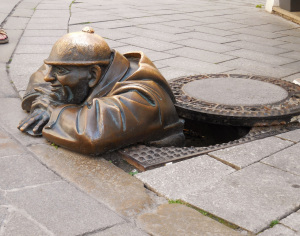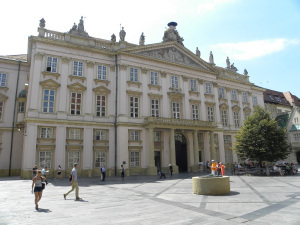Gem on the Danube
Napolean’s soldier leans on a bench in the busy square, smiling sardonically at the passersby. If people are surprised by the sight of him, it is because many are unaware that Napoleon’s soldiers were seen twice in the city, first in December 1805, after the battle of Austerlitz, and then again when Napoleon entered the city.
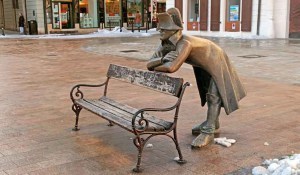 Napolean’s soldier stands on the square
Napolean’s soldier stands on the squareA sewer worker named Cumil peeps out of a manhole and a cheerfully-waving man with a top hat draws the indulgent smiles of visitors. The waving man is Schöne Náci, who wandered the city streets dressed elegantly, doffing his hat at the women who walked past. A paparazzi aims his camera at the pedestrian from the corner of a street. They are all among the many interesting statues that dot the city.
Cumil stares at the passersby
In a light mood, I join a horde of tourists walking down the Old Town, who had descended for a day trip from Vienna. That’s the way it is with most tourists who visit the tiny capital. It really doesn’t matter since most of Bratislava’s sights are within a radius of a couple of kilometres. Unlike other European cities, sightseeing in this city doesn’t require too much planning or a frenetic rushing around. It is a perfect place for no-itinerary, no-checklist travel.
When Czechoslovakia split, Prague went to the Czechs and Slovakians were happy to bag Bratislava. Prague became one of the most popular tourist destinations while Bratislava continued to struggle and wriggle out of its commie past. Given that Slovakia is a very young nation, having attained the status in 1993, the city has made a valiant effort to shed its dull days. Called Pozsony by Hungarians and Pressburg by the Germans, the capital of Slovakia was once a quiet harbour on the Danube. The quiet port became an interesting place when, after the Turks occupied Hungary, Hungarians decided to move their capital to the city they called Pozsony.
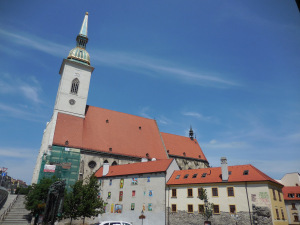 St. Martin’s Cathedral
St. Martin’s CathedralThen the powerful Habsburg monarch took control of the region and it became an important place with 11 royals being crowned in the historic St Martin’s cathedral. The Habsburgs ruled the country for 200 long years, building grand palaces and structures. Not too many of them have survived the onslaught of time, yet the tiny area of Old Town is replete with centuries-old buildings. Given the constant restorations, Bratislava can rightly boast of its marvellously conserved medieval buildings that bring tourists by the drove. The remnants of the communist era are interspersed with those of Maria Theresa’s opulent ones.
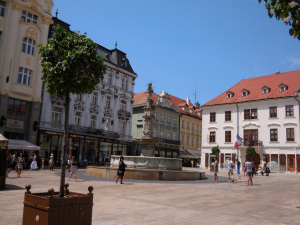 Old Town square
Old Town squareThe Slovakian capital may be small in size but the quaint old town promises many interesting sights along its constricted, winding cobbled streets. It was in Vienna that I came across a brochure about Bratislava and took an impromptu decision to join the hundreds of day-trippers to that city.
The Old Town, with its pedestrian-only rule, is an easy place to navigate. That is, if you don’t mind the truly narrow, cobbled streets. The Renaissance and Baroque mix Town Hall, Neo Renaissance Primatial Palace, St Michael’s Gate and most other structures are located within a radius of a couple of kilometres.
The Hlavné nám or Main Square is where the action lies. With the Roland’s Fountain, Napolean’s soldier and a plethora of cafes lining its sides, this is the favourite place of weary tourists sneaking in a tankard of beer before trudging through the streets once again. This is also where the walking tours begin.
At one end of the Main Square stands the neo-Gothic Old Town Hall, which houses the City Museum. The 15th century hall was reconstructed in the Renaissance style after being damaged by an earthquake.
Primate’s Palace
Nearby, the Primate’s Palace of 1778 is considered to be one of the most striking buildings in the city. The building is crested by a big cast iron cardinal’s hat, which stands as a testimony to the various cardinals who lived here. It was in the Hall of Mirrors of this palace that the historical Treaty of Pressburg was signed between Austrian emperor Franz I and Napolean.
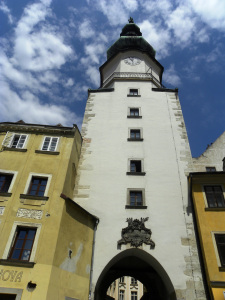 Michael’s Gate
Michael’s GateA short walk through the streets leads to the St Michael’s Gate, the only one remaining of the four gates to the Old Town. Topped with a statue of St Michael, the tower forms a part of the old fortification. A viewing platform on the top promises a panoramic view of the town, drawing visitors eager for a good photo-op.
A Prešporáčik (a tiny red train) hoots patiently as I amble towards the Gothic St Martin’s Cathedral at the end of the street. Built in the 13th century, this was where many kings and a queen—Maria Theresa—of the Habsburg monarchy were crowned. The cathedral has several chapels, which were added over the centuries. Interestingly, a replica of the Hungarian royal crown is positioned on the church tower. Although the exterior is not very impressive, the three-aisle interior has striking art work and exquisite stained-glass windows.
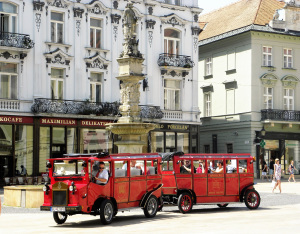 The little red bus that takes tourists around Old Town
The little red bus that takes tourists around Old TownThe modest Bratislava Castle, staring imperiously at the city from atop its hilly perch, was next on my agenda. The chosen site for fortresses since ancient times, it had once been a Roman outpost. The present castle has been reconstructed several times since it was first built. Featured on Slovak coins, the castle offers splendid views of the city.
Then there is the St Elizabeth’s Church or the Little Blue Church as it is fondly known. Built in the Art Nouveau style, it is adorned with beautiful blue Majolica tiles.
There are umpteen museums, art galleries and opera theatres for those interested in catching up with culture but then you need to do a little more than day-tripping to enjoy those.
Bratislava is definitely an underrated city on all counts, one that definitely needs to be included in the itinerary of those who are making a trip to eastern Europe.
Reaching there
Although Bratislava has its own airport, few tourists fly to the city. Most use a bus or a train, which takes just about an hour from Vienna. The ‘Bratislava Ticket’ offered by OBB costs 15 euros round-trip per person (adult) and includes free use of buses and tram at Bratislava. There are boats from Vienna that take tourists along the much-romanticised Danube.
Getting around
The old town is a pedestrian-only zone but those who do not wish to walk can take the quaint tourist train.
Accommodation
For those planning more than a day-trip, Bratislava has a range of hotels from the top end to the budget. Marrol’s Boutique Hotel and Double Tree Hilton are at the expensive end. There are many low-cost hotels as well as hostels.
Food
Slovakian cuisine is an amalgamation of the Hungarian, Austrian and local cuisine. The local favourite, bryndzové halusky (Slovak version of dumplings), is a concoction of potato-noodles with egg and sharp cheese along with bits of bacon. Bratislavsk ro‑ok (walnut or poppy seed-filled croissant) and local beer are very popular. Also popular are Kapustnica (soup made of sour cabbage and smoked pork sausage) and Slovak Goulash. Brave travellers can sample the Slivovice, a plum brandy with an alcohol content of 50 per cent that dates back to the 16th century.
Shopping
After Vienna, Bratislava comes as a pleasant surprise for the budget travellers. The city is really inexpensive. Amber, lace and ceramic objects are worth buying.
Best time to visit
May and June are the best times to visit the city because of the mild weather. Those planning to go to Bratislava during the winter must visit the Christmas market when the locals gather at the city centre to enjoy loke (potato pancakes) and drink mulled wine.
(Published in The Week on 25 October, 2015)
Filed under: Travel, Wine and Cuisine Tagged: Bratislava, Cumil, Czechoslovakia, Hapsburgs, Maria Theresa, Napolean's soldier, Old Town, Prague, Primate's Palace, Ruberneck, Schöne Náci, Slovakia, St Michael's Gate, St. Martin's Cathedral, The Little Red Bus, Vienna 








